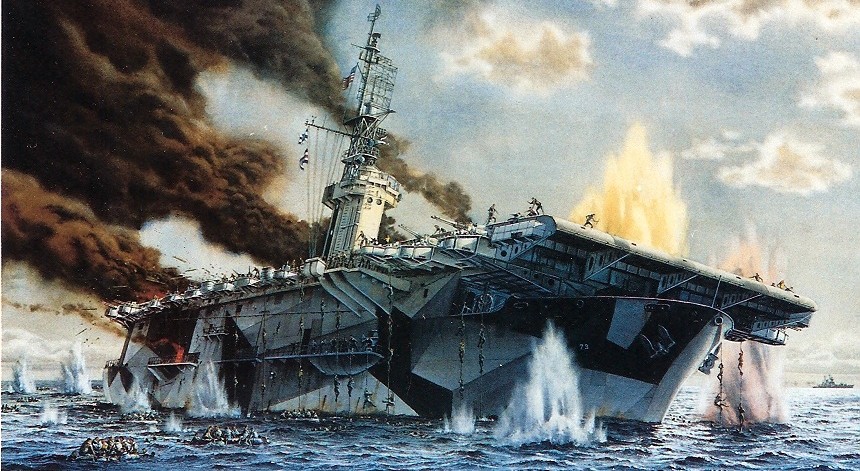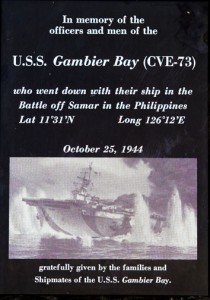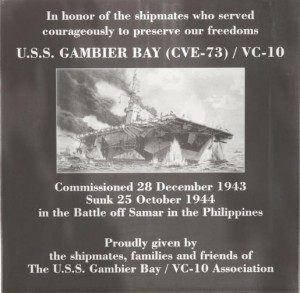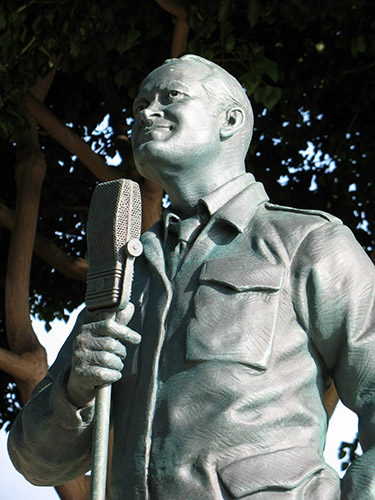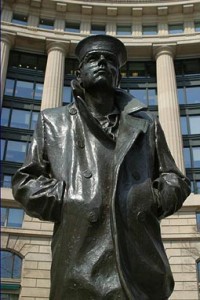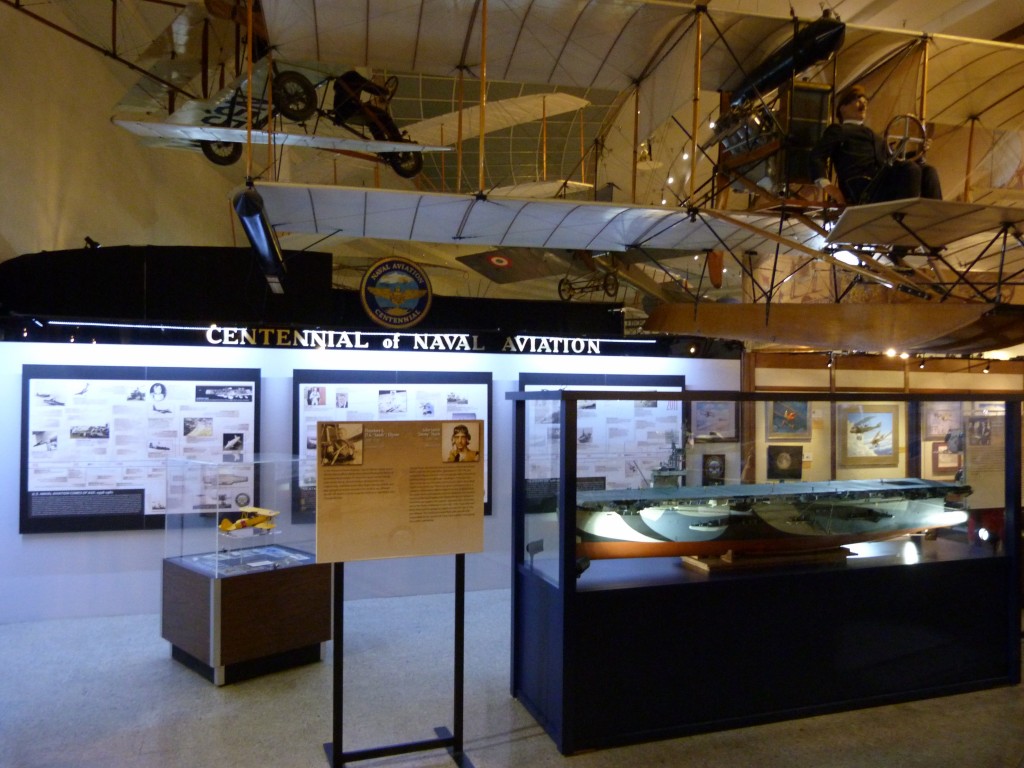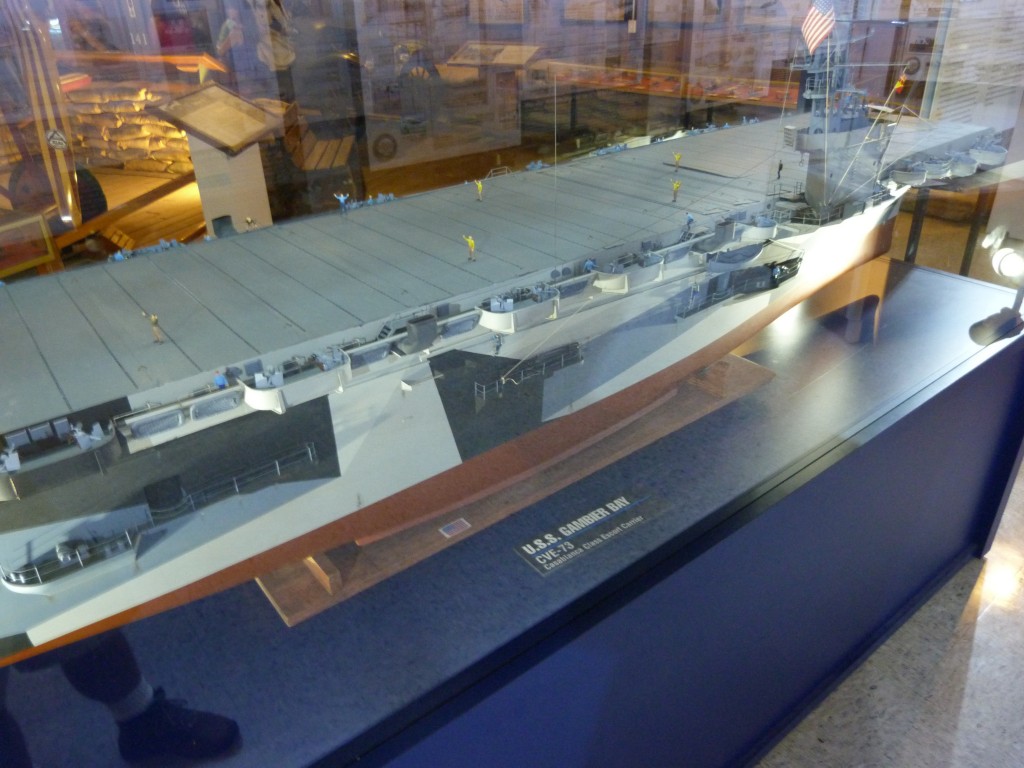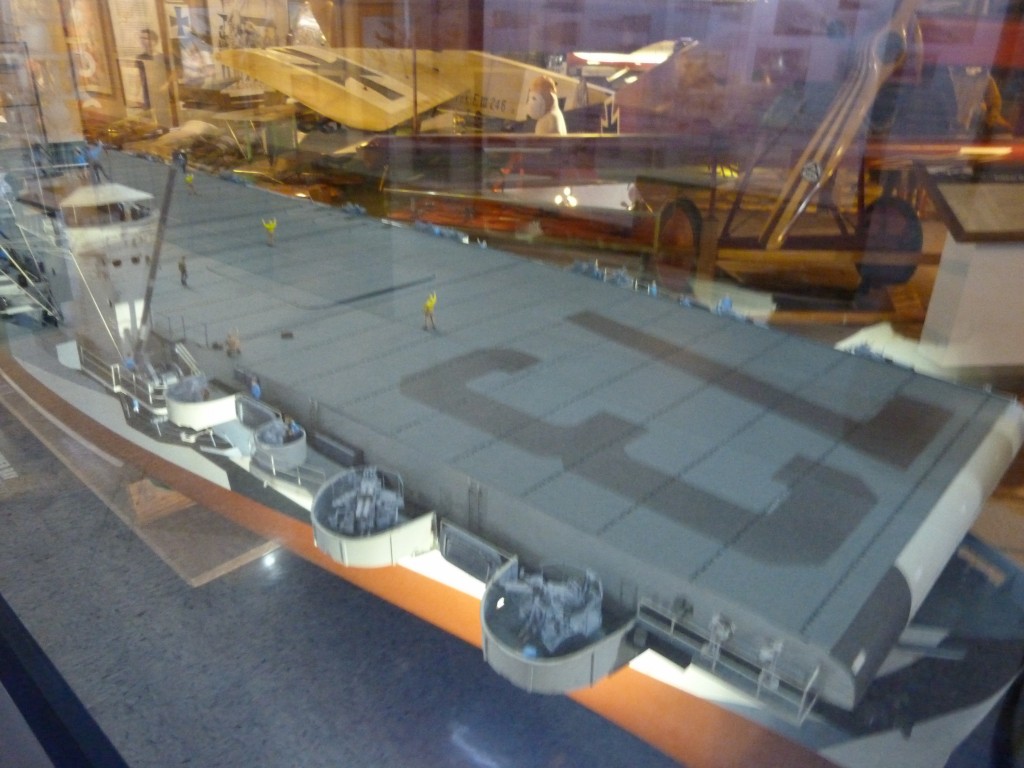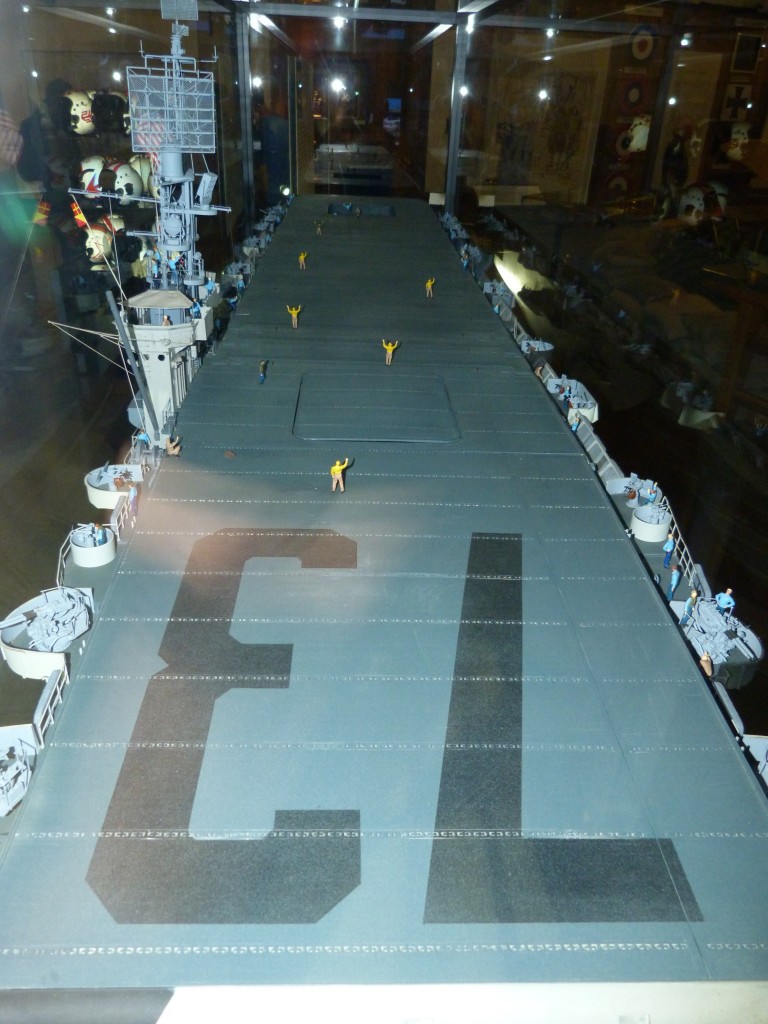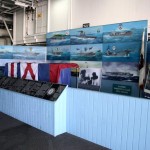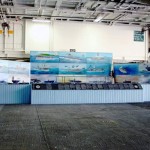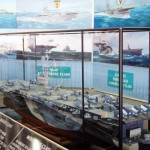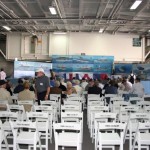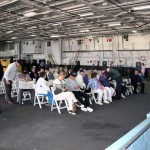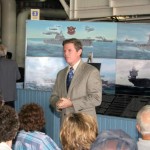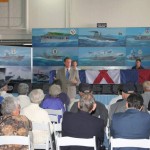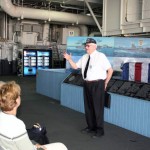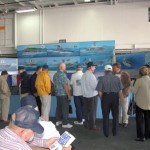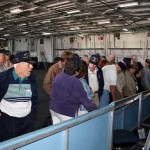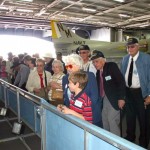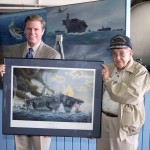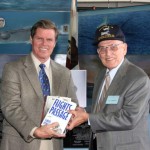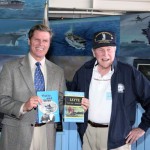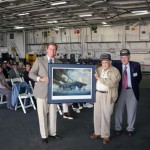National Museum of the Pacific War
Fredricksburg, Texas
Memorial Plaques to Honor Those Who Served – Individuals, ships, or units from all United States and Allied branches of service that served in the Pacific during WWII may be honored on the Memorial Wall.
The USS Gambier Bay/VC-10 Association has two memorial plaques located at the Museum to honor all those who served on the ship.
Location – Original Wall E
Location: Bracket Wall 4, Row 1
~ ~ ~ ~ ~
Fort Rosecrans National Cemetary
Point Loma, California
USS Gambier Bay (CVE-73) Memorial
A two section granite memorial dedicated to the memory of the 107 men who gave their lives to their country in the Battle of Leyte Gulf in October 1944.
The Memorial was dedicated on 24 October 1996.
During the Battle of Leyte Gulf each of the three task units of the U.S. Seventh Fleet’s Task Group 77.4 had six small Casablanca-class escort carriers, and seven or eight lightly armed and unarmored destroyers and/or smaller destroyer escorts.
Admiral Thomas Sprague’s Task Unit 77.4.1 (“Taffy 1”) consisted of the escort carriers Sangamon, Suwannee, Santee, and Petrof Bay.
Admiral Felix Stump’s Task Unit 77.4.2 (“Taffy 2”) consisted of Natoma Bay,
Manila Bay, Marcus Island, Kadashan Bay, Savo Island, and Ommaney Bay.
Admiral Clifton Sprague’s Task Unit 77.4.3 (“Taffy 3”) consisted of Fanshaw Bay,
St Lo, White Plains, Kalinin Bay, Kitkun Bay, and Gambier Bay. Screening for Taffy 3 were the destroyers Hoel, Heermann, Johnston, and destroyer escorts USS Dennis, John C. Butler, Raymond, and Samuel B. Roberts.
During the battle Admiral Clifton Sprague’s task unit 77.4.3 lost two escort carriers: (Gambier Bay, to surface attack and St. Lo, to Kamikaze attack).
Of the seven screening ships two destroyers (Hoel and Johnston) and a destroyer escort (Samuel B. Roberts) were lost, as were dozens of aircraft and crews. The other four U.S. destroyers were damaged with crewmen killed.
~ ~ ~ ~ ~
Fort Rosecrans National Cemetary
Point Loma, California
Taffy III Memorial
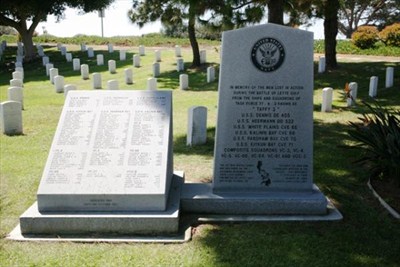 A two section granite memorial dedicated to the memory of the 107 men who gave their lives to their country in the Battle of Leyte Gulf in October 1944. Memorial was dedicated on 24 October, 1996. During the Battle of Leyte Gulf each of the three task units of the U.S. Seventh Fleet’s Task Group 77.4 had six small Casablanca-class escort carriers, and seven or eight lightly armed and unarmored destroyers and/or smaller destroyer escorts. Admiral Thomas Sprague’s Task Unit 77.4.1 (“Taffy 1”) consisted of the escort carriers Sangamon, Suwannee, Santee, and Petrof Bay. Admiral Felix Stump’s Task Unit 77.4.2 (“Taffy 2”) consisted of Natoma Bay, Manila Bay, Marcus Island, Kadashan Bay, Savo Island, and Ommaney Bay. Admiral Clifton Sprague’s Task Unit 77.4.3 (“Taffy 3”) consisted of Fanshaw Bay, St Lo, White Plains, Kalinin Bay, Kitkun Bay, and Gambier Bay. Screening for Taffy 3 were the destroyers Hoel, Heermann, Johnston, and destroyer escorts USS Dennis, John C. Butler, Raymond, and Samuel B. Roberts. During the battle Admiral Clifton Sprague’s task unit 77.4.3 lost two escort carriers: (Gambier Bay, to surface attack and St. Lo, to Kamikaze attack). Of the seven screening ships two destroyers (Hoel and Johnston) and a destroyer escort (Samuel B. Roberts) were lost, as were dozens of aircraft and crews. The other four U.S. destroyers were damaged with crewmen killed.
A two section granite memorial dedicated to the memory of the 107 men who gave their lives to their country in the Battle of Leyte Gulf in October 1944. Memorial was dedicated on 24 October, 1996. During the Battle of Leyte Gulf each of the three task units of the U.S. Seventh Fleet’s Task Group 77.4 had six small Casablanca-class escort carriers, and seven or eight lightly armed and unarmored destroyers and/or smaller destroyer escorts. Admiral Thomas Sprague’s Task Unit 77.4.1 (“Taffy 1”) consisted of the escort carriers Sangamon, Suwannee, Santee, and Petrof Bay. Admiral Felix Stump’s Task Unit 77.4.2 (“Taffy 2”) consisted of Natoma Bay, Manila Bay, Marcus Island, Kadashan Bay, Savo Island, and Ommaney Bay. Admiral Clifton Sprague’s Task Unit 77.4.3 (“Taffy 3”) consisted of Fanshaw Bay, St Lo, White Plains, Kalinin Bay, Kitkun Bay, and Gambier Bay. Screening for Taffy 3 were the destroyers Hoel, Heermann, Johnston, and destroyer escorts USS Dennis, John C. Butler, Raymond, and Samuel B. Roberts. During the battle Admiral Clifton Sprague’s task unit 77.4.3 lost two escort carriers: (Gambier Bay, to surface attack and St. Lo, to Kamikaze attack). Of the seven screening ships two destroyers (Hoel and Johnston) and a destroyer escort (Samuel B. Roberts) were lost, as were dozens of aircraft and crews. The other four U.S. destroyers were damaged with crewmen killed.
* * * * *
Task Unit 77.4.3 (Taffy III)
Escort Carriers
USS Fanshaw Bay – CVE-70 & VC-68 – Capt. D.P. Johnson/Flagship
USS Gambier Bay – CVE-73 & VC-10 – Capt. W.V.R. Vieweg
USS Kalinin Bay – CVE-68 & VC-3 – Capt. T.B. Williamson
USS Kitkun Bay – CVE-71 & VC-5 – Capt. J.P. Whitney
USS St. Lo – CVE-63 & VC-65 – Capt. F.J. McKenna
USS White Plains – CVE-66 & C-4 – Capt. D.J. Sullivan
Destroyers
USS Heerman – DD-532 – Cdr. Amos T. Hathaway
USS Hoel – DD-533 – Cdr. L.S. Kintberger
USS Johnson – DD-557 – Cdr. Ernest E. Evans
Destroyer Escorts
USS John C. Butler – DE-339 – Lt. Cdr. J.E. Pace
USS Dennis – DE-405 – Lt. Cdr. Samuel Hanse
USS Raymond – DE-341 – Lt. Cdr. A.F. Beyer
USS Samuel B. Roberts – DE-413 – Lt. Cdr. R.W. Copeland
~ ~ ~ ~ ~
National World War II Memorial
Washington, DC
The memorial honors the 16 million who served in the armed forces of the U.S. during World War II, the more than 400,000 who died, and the millions who supported the war effort from home. Symbolic of the defining event of the 20th Century, the memorial is a monument to the spirit, sacrifice, and commitment of the American people to the common defense of the nation and to the broader causes of peace and freedom from tyranny throughout the world. It will inspire future generations of Americans, deepening their appreciation of what the World War II generation accomplished in securing freedom and democracy. Above all, the memorial stands as an important symbol of American national unity, a timeless reminder of the moral strength and awesome power that can flow when a free people are at once united and bonded together in a common and just cause.
~ ~ ~ ~ ~
Battle of Leyte Gulf Memorial by Taffy 3 and Admiral Sprague Bust
San Diego, California
This beautiful monument is dedicated to the memory of Vice Admiral Clifton A. F. Sprague and the 13 ships and 7,300 men of Task Unit 77.4.3, also known as Taffy 3, which were under his command during the furious and heroic naval action fought off the island of Samar on October 25, 1944, during the Battle for Leyte Gulf.
The monument, located in a waterfront park along Harbor Drive, south of Navy Pier, consists of thirteen polished black granite panels – one for each ship – that stand five feet high and are arrayed in a V-shape plan. The centerpiece of the monument is a Moon Kim bronze bust of Admiral Sprague mounted on a solid black granite pedestal. Historical information and data about the ships and battle are inscribed on the base of the pedestal and the adjoining vertical panels.
During the commemorated battle, the lightly armed and unarmored Taffy 3 escort carriers, destroyers and destroyer escorts were attacked by an overwhelmingly superior force of Japanese battleships, cruisers and destroyers. Threatened with almost certain annihilation of his force, Admiral Sprague coolly and brilliantly directed his ships and planes in maneuvers and counter-attacks that bewildered the enemy and repulsed his onslaught.
The incredible courage and tenacity shown by the sailors and pilots of Taffy 3 deprived the Japanese of certain victory. Four Taffy 3 ships and over 800 men were lost in the action, but their sacrifice prevented a serious disruption of the U.S. amphibious landings at Leyte Gulf and contributed to the overall victory of the U.S. Navy in the last and greatest battle between opposing fleets in World War II.
~ ~ ~ ~ ~
National Salute to Bob Hope and the Military
San Diego, California
About the Sculptures: The bronze figures are sculpted in military uniforms authentic to the various eras of Bob’s career from World War II through the Korean War, Vietnam War, Cold War, and the first Persian Gulf War.
World War II Paratrooper
The 101st division (the Screaming Eagles) was activated on 15 August 1942 at Camp Claiborne, Louisiana on 19 August 1942. During World War II, the Pathfinders of the 101st Airborne Division led the way on D-Day in the night drop prior to the invasion. On 2 August 1944, the division became part of the First Allied Airborne Army. As part of this formation it took part in Operation Market Garden in the Netherlands. During the Battle of the Bulge the 101st defended the vital road junction of Bastogne. Brigadier General Anthony McAuliffe replied to the demand for surrender: “To the German Commander: NUTS! —The American Commander.” (Some are convinced that what he actually wrote was less polite.) The division held its ground. This figure is of a sergeant in the 101st Airborne paratroopers, (not a pathfinder), who participated in the Normandy invasion.
Korean War Infantryman
We have chosen the 45th infantry division for this figure of a private for several reasons relating to the desire to honor Native American veterans. It was formed from citizen soldiers in the Southwestern U.S. It had at least two Native American Medal of Honor winners in the Korean War. Its insignia is the Native American thunderbird, and it is known as the Thunderbird division. The insignia is a strong clue for the viewing public the soldier may be Native American. Native Americans volunteered for service in Korea in higher proportion than any other identifiable ethnic group.
Gulf War Soldier in Desert Storm
Forty thousand women were deployed in Operation Desert Storm. Many, including those in the 82nd Airborne, were in combat and 16 were killed. This marks a change in American military history were many mothers with young children serve in the armed forces. The Desert Storm Gulf War soldier is an African American 2nd Lieutenant in the 82nd Airborne. The cast on her right leg emphasizes her combat role, and also serves to honor all wounded veterans. She has a notebook on her lap in anticipation of receiving an autograph from Bob Hope.
Korean War Sailor
More than 265,000 navy personnel served in Korea during the war. The U.S. Navy eliminated the North Korean navy, prevented and destroyed enemy troop landings, performed on-land reconnaissance, carried out allied troop landings, evacuated over 100,000 allied troops at Hungnam, bombarded shore positions, and launched thousands of aerial sorties. The Korean War sailor is a Seaman 1st Class, who will be holding one of the handles of the Gulf War soldier’s wheelchair. He is in his dress blues.
World War II Fighter Pilot
The World War II fighter pilot is a captain in the Army Air Force, with the 332nd Fighter Group (originally the 99th Fighter Squadron)—the Redtails—within the 15th Air Force. This group is famous for two reasons: 1) it is the only fighter escort group to lose no bombers to enemy fighters, and 2) it was composed entirely of African Americans. The 332nd shot down 111 German fighters, including at least two Me-262 jets, and earned 150 Distinguished Flying Crosses. They were also known as the Tuskegee Airmen because they were trained at Tuskegee Army Air Field in Tuskegee, Alabama. In 1949, pilots from the 332nd Fighter Group took first place in the Air Force National Fighter Gunnery Meet at Las Vegas Air Force Base, Nevada.
Vietnam War Artilleryman
This soldier is a private in an artillery unit from the Vietnam War. He is holding a home-made sign which reads “Go Bob!” He is wearing a T-shirt with no insignia, with his dog tags outside his shirt. US artillery in Vietnam was organized under I Field Force, II Field Force and XXIV Corps Artillery, consisting of 44 battalions in total. These battalions played a significant role in supporting American and allied infantry.
Vietnam War Air Force Mechanic
The mechanic is a Hispanic technical sergeant in the Air Force in the Vietnam War, seated on a wooden ammo box. A little remembered episode is that the first Air Force mechanics in Vietnam were sent in support of the French for seven months in 1954, in a deployment that grew to nearly 500 men. Their base at Do Son was under frequent attack, and the Viet Minh captured 5 men.
World War II Marine Corps Sergeant
The sculpture is of a patient from the 44th Field Hospital, one of the largest fully equipped hospitals in the Philippines during World War II. The Medical Statistics Division of the Office of the Surgeon General has estimated that close to 15,000 men in the U.S. Army, including Army Air Forces, suffered amputations during the period from 1 January 1942 to 31 March 1946. The maximum census reported by these amputation centers for any one month was 9,240 in June 1945. The figure is depicted in his issue blue robe, freshly pinned with the Purple Heart. “Bedside presentations” of this award, which would typically entail a general entering a hospital with a box of Purple Hearts, pinning them on the pillows of wounded service members, and then departing with no official records kept of the visit or the award. Service members themselves could complicate the issue by leaving hospitals unofficially, returning to their units. In such cases, even if a service member had received actual wounds in combat, the award of the Purple Heart might never be recorded in official records.
Korean War Marine
This sculpture of a Korean War Marine is of an African-American Marine shown in the standard issue cold-weather uniform required by the harsh Korean winter. Holding a sign marked “Thanks for the Memory” he communicates the support and appreciation of U.S. troops for Bob Hope and his efforts with the USO. African-American servicemen distinguished themselves in combat during the ground battles with the North Korean army and in the air war over Korea. The Korean War is considered by many as the turning point in the acceptance of African-Americans as proven members of the U.S. military. Following the Korean War, the Army abolished the 300 segregated all-black units that had previously existed and integrated the more than 300,000 African-Americans into the previously all-white units.
World War II Navy Machinist Mate
This figure is a portrait of a Machinist Mate, Third Class Petty Officer (PO3) from the USS Lark. The subject is depicted from the year 1944 as he would have appeared while stationed at MiosWoendi “Windy Island” in the South Pacific. The sculpture represents a sailor who served during the Battle of Leyte Gulf, which was fought in the seas around the Philippines following the initial landings and return of U.S. forces to these islands in October 1944. Consisting of four major air-sea battles fought over several days, including Taffy 3’s famous action in the Battle off Samar on 25 October, the Battle of Leyte Gulf was the greatest naval battle in history. In a last and desperate gamble to halt the advance of allied forces in the Pacific, most of the remaining major units of the still-formidable Imperial Japanese Navy were sent forth into this battle. In the Sibuyan Sea, off Cape Engaño, in Surigao Strait and off the island of Samar, U.S. sailors and airmen met, repulsed and defeated the Japanese fleet in this the last great naval battle between opposing fleets in World War II. The figure is depicted standing on a box in dungarees that were modeled from original period clothing acquired from the family of a World War II veteran. Further refinement to the uniform was based on information provided through oral history given by Hal Tinker, retired US Navy. The figure is a Caucasian male of approximately 22 years of age. The age of the sailor is based on footage of members of the audience at the MiosWoendi performance by Bob Hope featured on The Best of Bob Hope: The Ultimate Collection, “Bob Goes to War”.
Coast Guard Squadron One
The uncharted nature of the waters surrounding Vietnam made the members of the U.S. Coast Guard an invaluable component in military efforts in the region. Crewmen assisted in patrols, rescues, and topography. Early on in the conflict, it was determined that the Coast Guard would provide seventeen 82-foot patrol boats. On 29 April 1965, the formation of Coast Guard Squadron One was announced. On 6 May, the Coast Guard ordered the deployment of the seventeen patrol boats and only twelve days later they were loaded on merchant vessels in New York, Norfolk, New Orleans, Galveston, San Pedro, San Francisco and Seattle. At Coast Guard Base Alameda, Coast Guard Squadron One was formed. Initially, 47 officers and 198 enlisted were assigned to the newly formed Squadron One. The 82-footer’s main job was choking off the enemy’s sea-borne supplies. The Squadron would become the backbone of the Coast Guard’s fleet. Hispanics played a valuable role in the Vietnam war and accounted for 25 percent of the casualties. Their contributions have been particularly linked to the Coast Guard where a Hispanic crewman was awarded a Purple Heart.
Gulf War Air Force Staff Sergeant
The sculpture features an Asian-American female of approximately 22 years of age, a Staff Sergeant from the Communications Squad stationed in Kuwait City in 1990. Age of the figure was established from oral history from a member of the U.S. Air Force who had served in Kuwait. Sixteen percent of veterans from Desert Storm are women, and by 1993 over 50,000 Asian-Americans were in uniform. The figure is shown standing wearing a standard issue Battle Dress Uniform (BDU) with standard-issue desert combat boots. Reference for the uniform was provided by a Desert Storm veteran who loaned the uniform she had worn while serving in the Gulf to the artist.
World War II Navy Pilot Lieutenant
This World War II pilot is a Lieutenant in the Navy, fighting in the conflict in the Pacific. Thirty years after the Navy had acquired its first airplane and only 19 years after it had acquired its first aircraft carrier, naval aviation faced the supreme test of war. At the beginning of the war the Navy and Marine Corps air arms could muster only seven large and one small aircraft carriers, 5 patrol wings and 2 Marine aircraft wings, 5,900 pilots and 21,678 enlisted men, 5,233 aircraft of all types including trainers, and a few advanced air bases. World War II marked the first time in history naval engagements were fought entirely in the air without opposing surface forces sighting each other. In the course of the war, Navy and Marine pilots destroyed over 15,000 enemy aircraft in the air and on the ground, sank 174 Japanese warships, including 13 submarines, totaling 746,000 tons, sank 447 Japanese merchant ships totaling 1,600,000 tons and, in the Atlantic, destroyed 63 German U-boats. The pilot in this figure is seen with his Mae West in a light summer flight suit worn to protect against the heat and humidity. He is shown wearing non-standard boots based on oral histories from Navy pilots who explained that the pilots often wore different boots out of fear that the standard-issue foot wear would become water logged in the event of a sea landing.
Vietnam War Navy Medic
This figure is a Hospital Corpsman Third Class, U.S. Navy, from Quang Nam Province from 1968. With the escalation of the Vietnam conflict between 1963 and 1975, Hospital Corpsman were called to serve in Southeast Asia. They served in Marine Corps and Navy Air/Ground Forces, Naval Support Activity Hospitals, off the coast of North Vietnam, in Cambodia and in Thailand. They performed emergency treatment in all kinds of combat conditions. They were assigned to small medical teams that provided care and health advice to Vietnamese civilians. Some were assigned as medical advisors to Vietnamese military units, which required that they live in small, poorly defended villages. Hospital Corpsman truly felt the brunt of the Vietnam conflict. Six hundred twenty were killed or mortally wounded and another 3,353 were wounded in action. Awards for gallantry and intrepidity in action included 3 Congressional Medals of Honor, 29 Navy Crosses, 127 Silver Stars, 2 Legions of Merit, 290 Bronze Stars and 4,563 Purple Hearts. The subject’s uniform is completed with standard-issue drawstring pants, based on reference photographs in U.S. Military Operations 1945-1985 by Kenneth Anderson and combat boots, based on reference photographs from Left at the Wall: Artifacts from the Vietnam Veterans Memorial. He is posed sitting on top of an ammunition box suggesting the often-makeshift nature of Hope’s impromptu stages. He is wearing no shirt reflecting the more casual nature of the USO performances in Vietnam. The figure’s dog tags are thrown around his back to allow him to clap.
World War II Army Nurse
More than 59,000 American nurses served in the Army Nurse Corps during World War II. During the conflict, nurses worked closer to the front lines than they ever had before. Within the “chain of evacuation” established by the Army Medical Department during the war, nurses served under fire in field hospitals and evacuation hospitals, on hospital trains and hospital ships, and as flight nurses on medical transport planes. In all, more than 200 Army Nurses lost their lives during World War II. The skill and dedication of these nurses is credited for the extremely low post-injury mortality rate among American military forces in every theater of the war. Army nurses all served as officers and were slightly older than some of the soldiers they tended. This figure is seen in her regulation uniform. She is sketching a character of Bob Hope with a love heart.
~ ~ ~ ~ ~
The Lone Sailor©
The Lone Sailor© is a composite of the U.S. Navy bluejacket, past, present and future. He’s called the Lone Sailor, yet he is hardly ever alone, standing there on the broad granite plaza which forms the amphitheater of the Navy Memorial. Visitors to the Memorial are immediately drawn to him to peer into his far seeing eyes, to admire him or size him up, to see if he’s as tough or as gentle as he seems. Visitors find that he is all that he seems and probably more.
The founders of the Navy Memorial envisioned this Lone Sailor at 25 years old at most, a senior second class petty officer who is fast becoming a seagoing veteran. He has done it all – fired his weapons in a dozen wars, weighed anchor from a thousand ports, tracked supplies, doused fires, repelled boarders, typed in quadruplicate and mess-cooked, too. He has made liberty call in great cities and tiny villages, where he played tourist, ambassador, missionary to the poor, adventurer, souvenir shopper and friend to new lands. His shipmates remember him with pride and tell their grandchildren stories, some of which, like him, are seven feet tall.
~ ~ ~ ~ ~
USS Gambier Bay/VC-10 / Freedom’s Cost by R. C. Moore
In the early 1990’s, Mr. Moore was commissioned by the
USS Gambier Bay/VC-10 Association to do a painting.
Mr. Moore’s paintings of Navy and Historic ships of every period are in many private and corporate collections in the United States and abroad.
*
The original artwork of the Freedom’s Cost is located at the
Franklin D. Roosevelt Presidential Library in Hyde Park, New York.
~ ~ ~ ~ ~
USS Gambier Bay/VC-10 Exhibition
USS Midway Museum San Diego, California
Aboard the USS Midway in their museum, the USS Gambier Bay (CVE-73)/VC-10 exhibition was dedicated in October 2004. This exhibition remained on display until April 2013 when it was transferred to the San Diego Air and Space Museum in Balboa Park and housed in their Centennial of Naval Aviation Exhibit
* * * * *
Photos While at the San Diego Air and Space Museum
Exhibit is Located Right Before the WW1-era
The Exhibit is Part of the 100 Years of Naval Aviation
July 2014
Photos provided by Dan Bodenheimer (cousin of Dean Gilliatt {KIA})
* * * * *
Photos While at the USS Midway
~ ~ ~ ~ ~
U.S.S. Gambier Bay (CVE-73) / The Final Hour by C.G. Evers
Dye-colored splashes of shells fired by Japenese battleships straddle the escort carrier on 25 October 1944, during the battle of Leyte Gulf.
Commissioned by the U. S. Naval Institute to commemorate the men of the
U.S.S. Gambier Bay/VC-10.
Donated to the United States Naval Air Museum October 25, 1979
At this time, copies of the Final Hour are no longer available.
~ ~ ~ ~ ~
Other Memorial Displays
-
Hyde Park – Original of Freedom’s Cost painting and ship model
-
USS Yorktown (Charleston, NC) – Norman Loats shirt, diorama, and Huxtable exhibit
-
USS George Washington – Lithograph of Freedom’s Cost
-
Pennsacola, FL – Ship model
-
Astoria, OR – Ship model and Freedom’s Cost lithograph
-
Boston (museum unknown) – Freedom’s Cost lithograph
-
Great Lakes Training Station (Chicago, IL) – Freedom’s Cost lithograph
-
USS Hornet (Alameda, CA) – Ship model
-
USS Nimitz – Freedom’s Cost lithograph
-
MacArthur Museum (Norfalk, VA) – info pending
-
Pacific War Musem (Frederickburg, TX) – Freedom’s Cost lithograph/oral histories
-
Pacific War Museum (Honolulu, HI) – Oral history by Norman Loats
